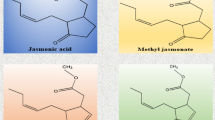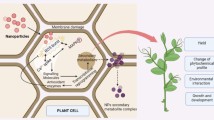Abstract
Elicitin-mediated acquisition of plant sterols is required for growth and sporulation of Phytophthora spp. This study examined the interactions between elicitins, sterols, and tannins. Ground leaf tissue, sterols, and tannin-enriched extracts were obtained from three different plant species (California bay laurel, California black oak, and Oregon white oak) in order to evaluate the effect of differing sterol/tannin contents on Phytophthora ramorum growth. For all three species, high levels of foliage inhibited P. ramorum growth and sporulation, with a steeper concentration dependence for the two oak samples. Phytophthora ramorum growth and sporulation were inhibited by either phytosterols or tannin-enriched extracts. High levels of sterols diminished elicitin gene expression in P. ramorum; whereas the tannin-enriched extract decreased the amount of ‘functional’ or ELISA-detectable elicitin, but not gene expression. Across all treatment combinations, P. ramorum growth and sporulation correlated strongly with the amount of ELISA-detectable elicitin (R 2 = 0.791 and 0.961, respectively).





Similar content being viewed by others
References
Behrman EJ, Gopalan V (2005) Cholesterol and plants. J Chem Educ 82:1791–1793
Bianco MA, Savolaninen H (1997) Phenolic acids as indicators of wood tannins. Sci Total Environ 203:79–82
Brummer M, Arend M, Fromm J, Schlenzig A, Osswald WF (2002) Ultrastructual changes and immunocytochemical localization of the elctin quercinin in Quercus robur L. roots infected with Phytophthora quercina. Physiol Mol Plant Pathol 61:109–120
Elliott CG, Hendrie MR, Knights BA (1966) The sterol requirement of Phytophthora cactorum. J Gen Microbiol 42:425–35
Evert RF (2006) Esau’s Plant Anatomy. Wiley, New Jersey
Fleischmann F, Koehl J, Portz R, Beltrame AB, Osswald W (2005) Physiological changes of Fagus sylvatica seedlings infected with Phytophthora citricola and the contribution of its elicitin “citricolin” to pathogenesis. Plant Biol 7:650–8
Folin O, Denis W (1912) On phosphotungstic-phosphomolbdic compounds as color reagents. J Biol Chem 12:239–245
Goheen EM, Hansen E, Kanaskie A, Osterbauer N, Parke J, Pscheidt J, Chastagner G (2006) Sudden oak death and Phytophthora ramorum. Oregon State University Extension Service
Gonzalez RA, Parks LW (1981) Lack of specificity in accumulation of sterols by Phytophthora cactorum. Lipids 16:384–388
Grant BR, Greenway W, Whatley FR (1988) Metabolic changes during development of Phytophthora palmivora examined by Gas Chromatography/Mass Spectrometry. J Gen Microbiol 134:1901–1911
Grunwald NJ, Goss EM, Press CM (2008) Phytophthora ramorum: a pathogen with a remarkably wide host range causing sudden oak death on oaks and ramorum blight on woody ornamentals. Mol Plant Pathol 9:729–40
Gunstone FD, Harwood JL, Padley FB (1994) The Lipid handbook. New York: Chapman and Hall. XIII, 722, 551 p
Hagerman AE, Butler LG (1981) The specificity of proanthocyanidin-protein interaction. J Biol Chem 256:4494–4497
Haskins RH, Tulloch AP, Mirceitich RG (1964) Steroids and the stimulation of sexual reproduction of species of Pythium. Can J Microbiol 10:187–195
Hazel WJ, Bean GA, Goth RW (1988) Relationship of potato leaf sterols to development of potato late blight caused by Phytophthora infestans on U.S. potato clones and breeding lines. Plant Dis 72:203–205
Hendrix JW (1970) Sterols in growth and reproduction of fungi. Annu Rev Phytopathol 8:111–130
Hoitink HAJ, Schmitthenner AF (1974) Relative prevalence and virulence of Phytophthora species involved in Rhododendron root rot. Phytopathology 64:1371–1374
Inoue KH, Hagerman AE (1988) Determination of gallotannin with rhodanine. Anal Biochem 169:363–9
Ivanova DG, Singh BR (2003) Nondestructive FTIR monitoring of leaf senescence and elictin-induced changes in plant leaves. Biopolymers 72:79–85
Jeong W-S, Lachance PA (2001) Phytosterols and fatty acids in Fig (Ficus carica var. Mission) fruit and tree components. J. Food Sci 66:278–281
Kamoun S, Klucher KM, Coffey MD, Tyler BM (1993) A gene encoding a host-specific elicitor protein of Phytophthora parasitica. Mol Plant-Microbe Interact 6:573–581
Latte KP, Kolodziej H (2000) Antifungal effects of hydrolysable tannins and related compounds on dermatophytes, mould fungi and yeasts. Z Naturforsch C 55:467–72
Leal JA, Friend J, Holliday P (1964) A factor controlling sexual reproduction in Phytophthora. Nature 203:545–546
Manter DK, Kelsey RG, Karchesy JJ (2007a) Antifungal activity of extracts and select compounds in the heartwood of seven western conifers toward Phytophthora ramorum. J Chem Ecol 33:2133–2147
Manter DK, Kelsey RG, Karchesy JJ (2007b) Photosynthetic declines in Phytophthora ramorum-infected plants develop prior to water stress and in response to exogenous application of elicitins. Phytopathology 97:850–6
Manter DK, Kolodny EH, Hansen EM, Parke JL (2010) Virulence, sporulation, and elicitin production in three clonal lineages of Phytophthora ramorum. Physiol Mol Plant Pathol 74:317–322
Mikes V, Milat M-L, Ponchet M, Panabieres F, Ricci P, Blein J-P (1998) Elicitins excreted by Phytophthora are a new class of sterol carrier proteins. Biochem Biophys Res Comm 245:133–139
Nagle AM, McPherson BA, Wood DL, Garbelotto M, Bonello P (2011) Relationship between resistance to Phytophthora ramorum and constitutive phenolic chemistry in coast live oak. For Pathol 41:464–469
Nelson KE, Pell AN, Doane BI, Giner-Chavez BI, Schofield P (1997) Chemical and biological assays to evaluate bacterial inhibition by tannins. J Chem Ecol 23:1175–1194
Nes WD, Stafford AE (1983) Evidence for metabolic and functional discrimination of sterols by Phytophthora cactorum. Proc Natl Acad Sci USA 80:3227–3231
Nes WD, Stafford AE (1984) Side-chain structural requirements for sterol-induced regulation of Phytophthora cactorum physiology. Lipids 19:544–9
Nes WD, Patterson GW, Bean GA (1980) Effect of steric and nuclear changes in steroids and triterpenoids on sexual reproduction in Phytophthora cactorum. Plant Physiol 66:1008–11
Noda M, Tanaka M, Seto Y, Aiba T, Oku C (1988) Occurrence of cholesterol as a major sterol compenent in leaf surface lipids. Lipids 23:439–444
Ockels FS, Eyles A, McPherson BA, Wood DL, Bonello P (2007) Phenolic chemistry of coast live oak response to Phytophthora ramorum infection. J Chem Ecol 33:1721–32
Osman H, Vauthrin S, Mikes V, Milat M-L, Panabieres F, Marais A, Brunie S, Maume B, Ponchet M, Blein J-P (2001) Mediation of elicitin activity on tobacco is assumed by elicitin-sterol complexes. Mol Biol Cell 12:2825–2834
Panabieres F, Marais A, le Berre J, Penot I, Fournier D, Ricci P (1995) Characterization of a gene cluster of Phytophthora cryptogea which codes for elicitins, proteins inducing a hypersensitive-like response in tobacco. Mol Plant-Microbe Interact 8:996–1003
Pernollet J-C, Sallantin M, Sallé-Tourne M, Huet J-C (1993) Elicitin isoforms from seven Phytophthora species: comparison of their physio-chemical properties and toxicity to tabacco and other plant species. Physiol Mol Plant Pathol 42:53–67
Porter LJ, Hrstich LN, Chan BG (1986) The conversion of procyanidins and prodelphinidins to cyanidin and delphinidin. Phytochemistry 25:223
Rizzo DM, Garbelotto M, Hansen EM (2005) Phytophthora ramorum: integrative research and management of an emerging pathogen in California and Oregon forests. Annu Rev Phytopathol 43:309–35
Shahidi F, Naczk M (1995) Food phenolics. Technomic Publishing Co., Lancaster
Sivakumaran S, Molan AL, Meagher LP, Kolb B, Foo LY, Lane GA, Attwood GA, Fraser K, Tavendale M (2004) Variation in antimicrobial action of proanthocyanidins from Dorycnium rectum against rumen bacteria. Phytochemistry 65:2485–97
Strumeyer DH, Malin MJ (1975) Condensed tannins in grain sorghum: isolation, fractionation, and characterization. J Agric Food Chem 23:909–14
Vauthrin S, Mikes V, Milat M-L, Ponchet M, Maume B, Osman H, Blein J-P (1999) Elicitins trap and transfer sterols from micelles, liposomes and plant plasma membranes. Biochim Biophys Acta Protein Struct Mol Enzymol 1419:335–342
Vleeshouwers VGAA, van Dooijeweert W, Govers F, Kamoun S, Colon LT (2000) The hypersensitive response is associated with host and nonhost resistance to Phytophthora infestans. Planta 210:853–864
Yousef LF, Yousef AF, Mymryk JS, Dick WA, Dick RP (2009) Stigmasterol and cholesterol regulate the expression of elicitin genes in Phytophthora sojae. J Chem Ecol 35:824–32
Acknowledgements
Funding for this research was provided by the US Department of Agriculture, Forest Service, Pacific Southwest Research Station. We thank Ellen Goheen, U.S. Forest Service, for assistance in collecting the black oak leaves in 2007, and Mr. Dale Gray for allowing the sampling of leaves from his ornamental California bay laurel in 2007 and 2008. We also thank Doug Westlind, U.S. Forest Service, for help collecting the black oak leaves in 2008. The research collaboration of M.P. González-Hernández was funded by the Ministry of Education and Science of Spain (Dirección General de Universidades).
Author information
Authors and Affiliations
Corresponding author
Rights and permissions
About this article
Cite this article
Stong, R.A., Kolodny, E., Kelsey, R.G. et al. Effect of Plant Sterols and Tannins on Phytophthora ramorum Growth and Sporulation. J Chem Ecol 39, 733–743 (2013). https://doi.org/10.1007/s10886-013-0295-y
Received:
Revised:
Accepted:
Published:
Issue Date:
DOI: https://doi.org/10.1007/s10886-013-0295-y




